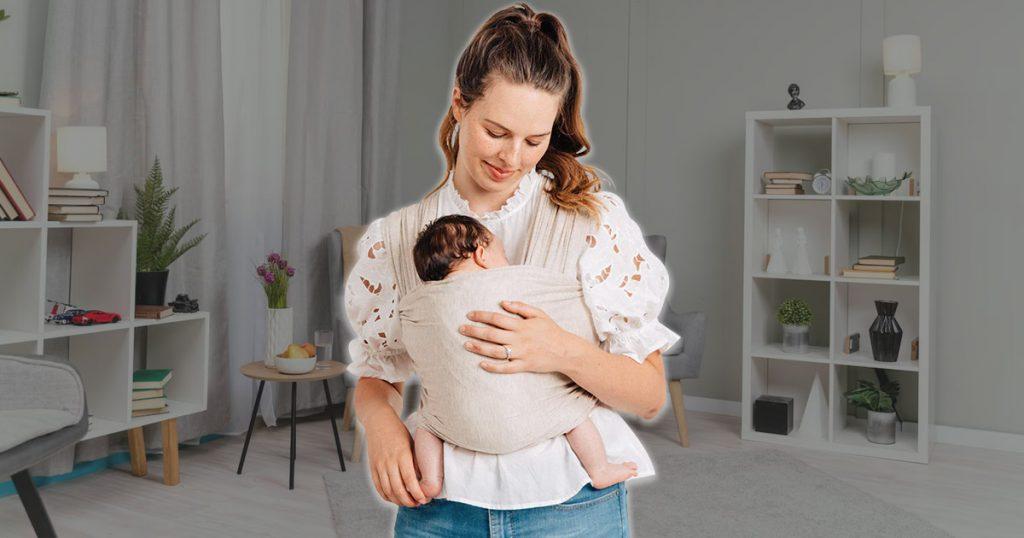Baby carriers are a lifesaver for many parents. They hold and support your baby while keeping your hands free. There are different types, like wraps, slings, and structured carriers, each designed for various stages of a baby’s growth. The main goal of a baby carrier is to keep your baby close, which helps with bonding, soothing, and supporting their physical and emotional development. Plus, they make it easier to do daily tasks, whether you’re shopping, doing chores, or taking a walk.
Research featured in the Academic Journal of Pediatrics and Neonatology shows that babies who are carried tend to cry less, sleep better, and develop faster mentally. Being close to you also helps them learn language as they hear and see everything around them.
Approximately 98% of parents surveyed stated they or their partner had used a baby carrier, sling, or wrap during the first year of the baby’s life, demonstrating the widespread popularity of baby carriers. This shows how helpful they are for making life easier and improving the quality of life for both parents and babies. Carriers are especially handy in crowded places where strollers can be a hassle, during travel, or whenever you need to be mobile but still keep your baby close.
Can You Put a Newborn in a Baby Carrier?
Baby carriers are very useful, but there are some safety concerns, especially for newborns. So, can you put a newborn in a baby carrier? Yes, but you need to use a carrier designed for newborns. These carriers provide good support for the baby’s head, neck, and hips.
Types of Carriers Fit for Newborns
- Wraps: These are long pieces of fabric that you wrap around yourself and your baby. Wraps can be adjusted to fit snugly and offer great support for a newborn’s head, neck, and hips.
- Slings: Made from a single piece of fabric that goes over one shoulder, slings allow you to carry your baby in different positions, including the cradle position, which is perfect for newborns.
- Soft Structured Carriers (SSCs): Some SSCs come with infant inserts or can be adjusted for newborns. They provide padded support and can be changed as your baby grows.
- Meh Dais: These carriers mix features of wraps and structured carriers. They have a rectangular fabric panel with straps that you tie around your waist and shoulders, giving good support for newborns.
These carriers make sure your newborn is safely positioned and comfortable, so you can enjoy babywearing right from the start.
Moreover, for the first few months, babies should also not face forward in these carriers. Here’s why:
- Head Control: Newborns can’t hold their heads up well yet. Facing forward can strain their neck muscles.
- Airway Safety: Facing inward keeps their airways clear and safe.
- Hip Development: The inward position supports healthy hip growth and reduces the risk of problems.
In the early months, babies should be carried close to your chest with their heads supported. Their legs should be in an “M” position, with knees higher than their bottom, to support healthy hips.
So, When Can Babies Face Forward in a Carrier?
Babies can usually start facing forward in a carrier between 4 to 6 months old. By this age, they have developed enough neck strength and head control to safely handle the forward-facing position.
Here’s why this time is ideal:
- Neck and Head Strength: Around 4 to 6 months, babies develop the muscles needed to hold their heads up without help.
- Curiosity: Babies at this age become more interested in their surroundings and enjoy looking around.
However, there are other important guidelines to keep in mind when using baby carriers:
- Leg Positioning: Babies can have their legs out in the carrier once they show proper hip and knee flexibility. This usually happens around the same time they can face forward. Make sure their legs form an “M” shape, with knees higher than their bottom, to support healthy hip development.
- Limit Duration: Start with short periods of forward-facing to avoid overstimulation and discomfort. Gradually increase the time as your baby gets used to it.
- Age and Weight Limits: Always check the carrier’s guidelines for age and weight limits to make sure your baby is safe.
By following these tips, you can use your baby carrier safely while supporting your baby’s growth and development.
Benefits of Baby Carriers for Both Parent and Babies
Baby carriers offer numerous benefits for both parents and babies. For parents, carriers provide a hands-free way to keep their baby close while managing daily tasks. This can be especially helpful when multitasking around the house or running errands. The physical closeness also helps strengthen the emotional bond between parent and child, promoting secure attachment.
For babies, being held in a carrier offers comfort and security, mimicking the warmth and rhythmic movements they experienced in the womb. This can lead to reduced crying and more contentment. Additionally, the upright position in a carrier can help with digestion and relieve colic symptoms.
However, parents should keep a few health tips in mind:
- Proper Fit: Make sure the carrier fits well to avoid back and shoulder strain. Adjust straps and waistbands for balanced weight.
- Good Posture: Stand up straight and don’t lean forward to prevent back pain while using the carrier.
- Take Breaks: Rest your body by taking regular breaks, especially during long periods of wearing the carrier.
By using baby carriers correctly, you and your baby can enjoy all these benefits.
